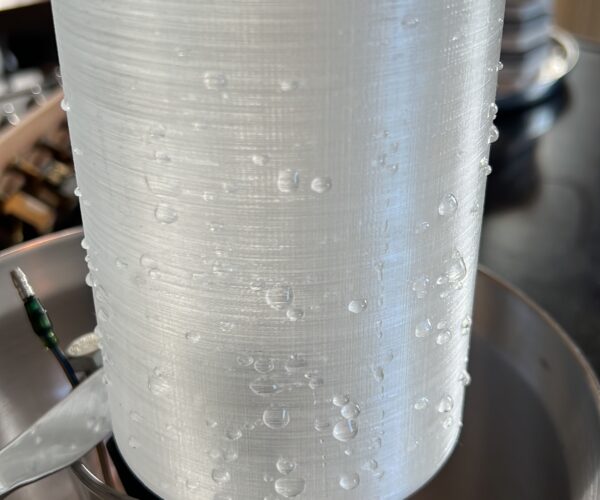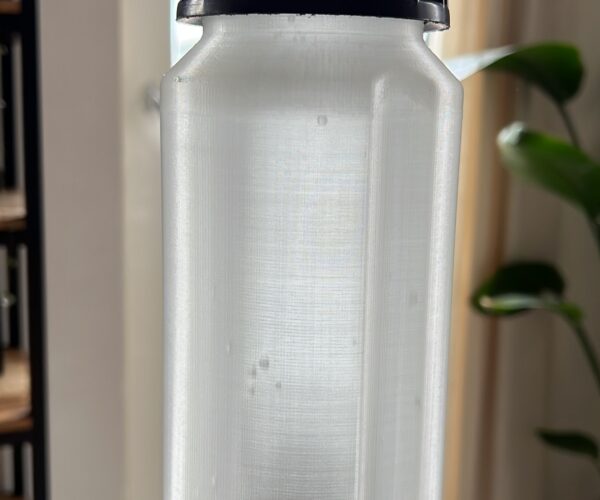Making a "watertight" oil reservoir (leaks at seam)
Hello all,
After printing a 30 hours oil reservoir bottle, I had mixed emotions.. It looked stunning, but was very dissapointed in finding out that it was leaking.
Before I printed the whole bottle, I made some test prints of the top and bottom. To ensure that the bottom of the reservoir was watertight, I used the 100% infill and a chamfered slope on the inside. After including some tips found on the forum and website, the test prints did not leak and all was to my satisfaction.
Printing the whole bottle took around 30 hours and the result is very nice, I am really happy with it... but it has one flaw, it cannot hold water and that what I can discover is that this is due to the seam.
Good to know that the majority of the settings are standard Prusa and one of this is the setting seam, which is "nearest". In this case it looks similar to "aligned" after reslicing the model.
I want to try the "random" setting of the seam, but before I redo my 30 hours print - I would like to know if anybody has already played with these different settings and can share there results.
Additional tips and tricks are of course more than welcome.
Setting and material:
- Prusament PETG Clear
- layerheight 0.1mm detail
- 100% infull
- 5 layers wall thinkness (which is 2mm)
- seam "nearest" (standard setting)
Thanks,
Koekoek3D
RE:
Maybe bump the extrusion multiplier a bit?
Or maybe some sealant of some kind in the internal seam area?
These articles may help:
https://blog.prusaprinters.org/watertight-3d-printing-pt1-vases-cups-and-other-open-models_48949/
https://blog.prusaprinters.org/watertight-3d-printing-part-2_53638/
In the early days of RepRap printers the tradition was that the first model printed on a newly assembled machine was a shot glass from which a spiritous tribute was quaffed ... you had to be quick though as they leaked so badly you only had a few seconds before the booze escaped.
Cheerio,
RE: Making a "watertight" oil reservoir (leaks at seam)
Thanks for both your replies. They helped me to have a better understanding how layers and seams are established. Although sealing the inside of the reservoir with a coating is the best option, it is really ugly (the bottle is transparant) and I will do anything to avoid this last option. I already tried this method on the original reservoir and it works, I suggest this for non-transparant applications.
Nevertheless I was a bit of in a hurry (I don't know why.. but ok) en reprinted the reservoir using the standard PETG settings for 0.15mm and set the seam to "random". Oh boy, that did not help at all, it leaks now everywhere:
So, third times a charm... currently printing the reservoir with 0.15mm and increased the nozzle temp to 250 (which was 230). Additionally I changed the perimeters to 4 and increased the flow-rate with 5%. The print is looking good so far, still 6 hours to go.
Looking for other articles I found the following knowledge base page: Prusa Knowledge Base | Watertight prints
Once the print is completed, I will post my results after I tested reservoir no.3 with water. ...fingers crossed...
RE: Making a "watertight" oil reservoir (leaks at seam)
Update
Yesterday the print finished succesfully. After removing some blobs and stringing, I filled the reservoir with water and 😀 no leaks at all. Even after a whole night no signs of leakage.

note that the air bubbles are inside the reservoir
Additionally I want to point out that the adjustments seems to help the transparency and finish. Not sure which’s of the adjustments are responsible. It looks overall better than both previous prints.
Also, I thought that an 0.15mm layer height would not give me the smoothness required for the treads at the top, but it is almost as precise as with printing this particular part at 0.10mm.
Next step is to exchange the water for oil, hoping that it can cope with it.. thanks again for your feedback and providing me with the right tools to solve this issue.
